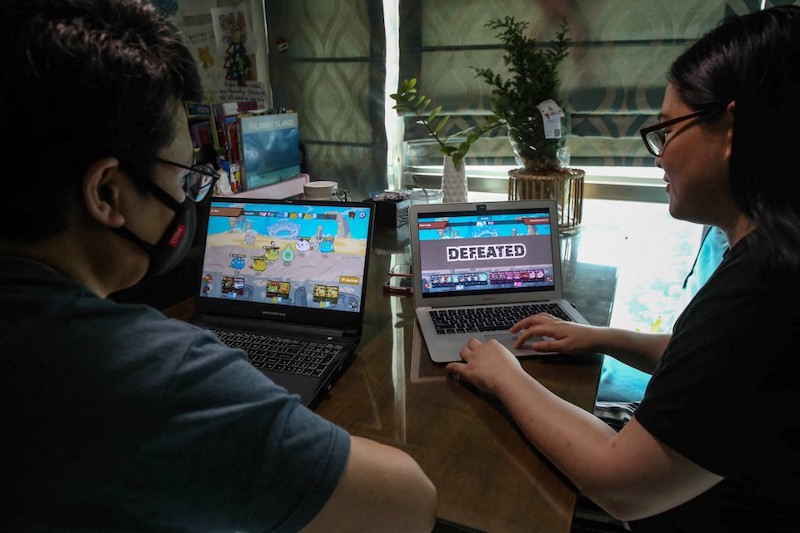Dominic Lumabi sits on the computer in his suburban Manila bedroom pitting his puffer fish-like cartoon non-fungible token (NFT) characters against others. But this is not just a game – he is earning cryptocurrency to support his family during the pandemic.
The source of his income is Axie Infinity, a blockchain-based play-to-earn game that exploded in popularity in developing nations such as the Philippines as Covid-19 destroyed jobs and forced many to stay home.
Its fans, financial backers and creators – Vietnam-based Sky Mavis – say it is a revolutionary step towards the future of the internet. Detractors warn the game is a house of cards, some likening it to a fraud scheme driven by hype and speculation.
“At first, I was sceptical because I thought it was a Ponzi scam,” said Lumabi, 26, who began playing last June after losing his job at an advertising firm and making a failed foray into online selling.
About 35% of Axie Infinity traffic – and the biggest share of its 2.5 million daily active users – comes from the Philippines, where high proficiency in English, strong gaming culture and widespread smartphone usage have fuelled its popularity, Sky Mavis said.
Exchange for Crypto
In Axie Infinity, players participate in battles using colourful blob-like Axies, and are mainly rewarded with a Smooth Love Potion (SLP) that can be exchanged for cryptocurrency or cash – or invested back into the game’s virtual world.
Lumabi plays for two hours a day in the tiny house he shares with his parents and four sisters, earning 8,000-10,000 pesos ($155-$195) per month – nearly half of what he makes at his current job as a content moderator working nine-hour graveyard shifts.
He has used Axie Infinity earnings for his sister’s university fees, groceries and bills – expenses his father’s struggling electrical repair business cannot cover.
The pandemic was the perfect environment for this game to attract players from all walks of life, said Leah Callon-Butler, a blockchain consultant based in the Philippines. “They could sit at home, protected from the virus, and play a cute game and earn money from it.”
But there is a catch. To play the game, players first have to purchase at least three Axies. An Axie is an NFT with a particular set of abilities and characteristics.
Like NFT pieces of art, they are stored on the blockchain – a digital ledger that cannot be changed. Axies can be bought, sold or rented to other players. Owners can also breed them to create new Axies that provide more value.
High Startup Cost
At the peak of the game’s growth last year, a starter team of Axies could cost hundreds of dollars, far beyond the reach of aspiring players in poorer countries. The cheapest Axies cost $37 each, putting the cost of a basic team at $111.
However, players who spend more get better Axies, giving them a better chance of winning battles to earn SLP and – from some activities – the game’s crypto token.
Those with the capital to assemble more lucrative Axie teams have set up guilds and “scholarships” – profit-sharing systems where players are charged a percentage of their earnings. The owners’ take can reportedly go as high as 30%.
“We provide the players with the assets that they need to generate income for themselves,” said Luis Buenaventura, who runs Yield Guild Games in the Philippines, one of the many companies offering scholarships. “In exchange for that, we ask for 10% of their earnings.”
YGG alone has 8,000 scholars and a queue of around 60,000 people waiting to join its programme that offers training and mentoring to a limited number of players at a time.
Buenaventura said many of his players were in their early 20s and from households making less than $400 a month. He described their monthly Axie winnings – about $200 – as “life-changing”.
Deep-Pocketed Backers
Sky Mavis earns revenue from the game mainly through marketplace fees, and Axie Infinity has generated more than $1.2 billion in revenue. It has also attracted deep-pocketed backers, including US billionaire Mark Cuban.
But some gaming industry analysts say its business model is unsustainable, pointing to the need for new players to keep money coming in. Jonathan Teplitsky of blockchain firm Horizen Labs warned most play-to-earn games were a “house of cards”.
He said they were fuelled by “hype and price speculation”. “This entire system works well while the Axie company is flush with cash and willing to fuel a massive marketing machine,” he said.
“If Axie wants to survive the next market crash, they will need to build some real-world utility into their game that does not depend on the mood of the markets.”
Sky Mavis co-founder and chief executive Trung Nguyen said Axie Infinity is “not a zero-sum game”, noting it is partly owned by players. “There are a lot of things other than monetary value that people can get from the game.”
- AFP, with additional editing by George Russell
READ MORE:
Malaysian Artist Explains Why Fortunes Are Spent on NFT Art
Asia Becomes the Epicentre of Global NFT Crypto Craze
NFTs Create Money Laundering Opportunities, Report Shows























